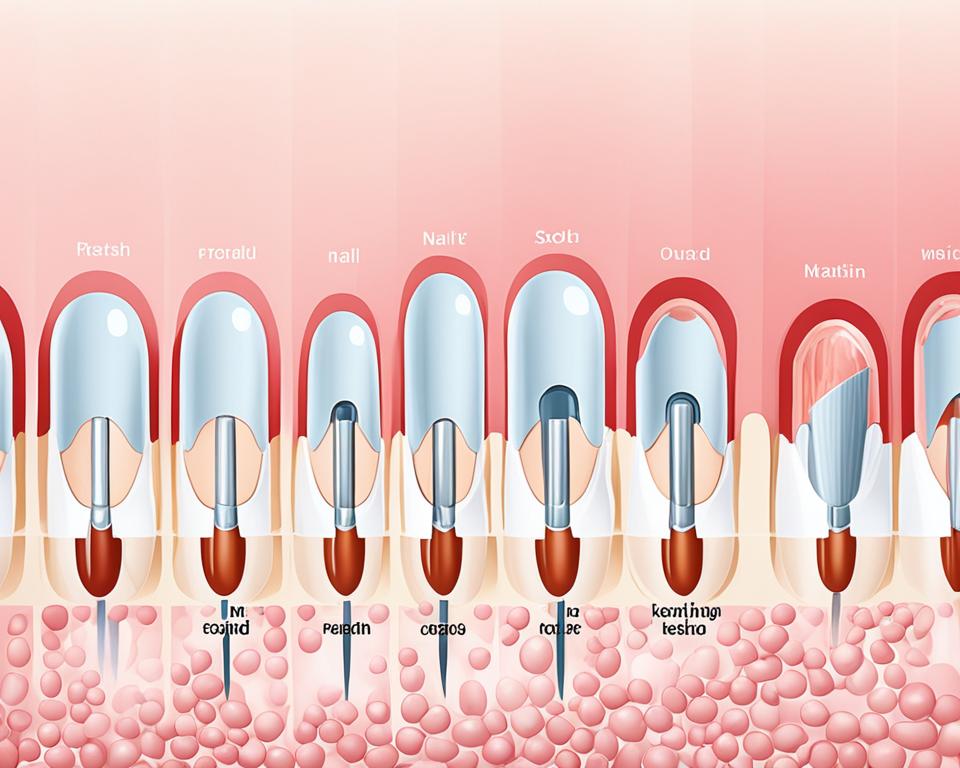Welcome to our exciting exploration of nails and their significance in the human anatomy. Have you ever wondered why we have nails and what purpose they serve? In this article, we’ll delve into the fascinating world of nails, from their evolutionary origins to their vital functions.
Nails are a distinctive feature of human anatomy, present not only on our fingers but also on our toes. They play a crucial role in our daily lives, enabling us to perform various tasks with ease. But what exactly is the structure of nails, and why are they so important?
Let’s take a closer look at the evolution of nails. We’ll uncover how they evolved from our primate ancestors and explore the transition from claws to the unique nail structure we have today. This journey will shed light on the significant role nails played in our evolution as a species.
Next, we’ll dive into the functions of fingernails and toenails. We’ll discover how they strengthen our grip, provide protection, enhance fine motor movements, and contribute to our overall balance. Understanding these functions will deepen our appreciation for the importance of nails in our daily lives.
As we delve further, we’ll explore the structure of nails. From the nail plate to the nail bed and cuticle, we’ll unravel the intricate composition that makes up our nails. Additionally, we’ll examine the process of nail growth and the role of keratin, the main component of our nails.
Furthermore, we’ll explore the link between nail health and underlying medical conditions. Our nails can provide valuable insights into our overall well-being. We’ll discuss common nail disorders and how they can act as indicators of various health concerns. Paying attention to changes in nail appearance is essential for early detection and maintaining optimal health.
In conclusion, nails are an integral part of human anatomy, serving a multitude of functions. Their evolution, structure, and health all contribute to their importance in our lives. Taking care of our nails through proper nail care and regular monitoring can help us preserve their functions and maintain overall well-being.
Key Takeaways:
- Fingernails and toenails are present in humans and other primates, serving various functions.
- Nails evolved from claws, enabling improved gripping and fine motor skills.
- Fingernails provide strength, protection, and enhance fine motor movements.
- Toenails primarily serve a protective role and assist in balance.
- Nails consist of the nail plate, nail bed, and cuticle, with keratin as the main component.
Evolutionary Reasons for Nails in Humans
As humans, our nails have evolved from a common ancestor that had claws. This evolution from claws to nails served a vital purpose in the development of our grip and fine motor skills, enabling us to manipulate objects with precision. Nails allowed our primate ancestors to pick up and handle small items, an ability that proved instrumental in their survival and progress.
Through the transition from living in trees to living in caves, our ancestors relied less on the need for sharp claws to cling onto branches and more on the dexterity provided by nails. This evolution opened up new possibilities as they honed their ability to create and utilize tools, a skill that set the stage for the remarkable progress of human civilization.
Understanding the shift from claws to nails provides valuable insights into the development of fine motor skills and our early ancestors’ adaptability. It highlights the significance of nails in our human anatomy as functional tools rather than vestigial remnants.
Functions of Fingernails and Toenails
Our fingernails and toenails serve vital functions beyond their aesthetic appeal. Let’s explore the various ways in which nails contribute to the strength, protection, and overall functionality of our hands and feet.
Strengthening and Grip
Fingernails play a crucial role in providing strength to the fingertips, enhancing our grip when holding objects and performing everyday tasks. The firmness and structure of the nails enable us to grasp items securely, allowing for improved dexterity and control.
Protection against Infections
Nails act as a protective barrier, shielding the delicate skin underneath from potential injuries and infections. By covering the nail bed, they act as a natural shield, preventing harmful bacteria and foreign substances from entering the fingertips and toes.
Enhancing Fine Motor Movements and Sensation
Have you ever scratched an itch or gently touched a delicate surface? These actions are made possible by our nails. Fingernails aid in enhancing fine motor movements, enabling us to perform intricate tasks such as writing, buttoning clothes, or playing musical instruments with precision.
In addition to this, our nails also contribute to our sense of touch. The nerve endings present in the fingertips and below the nails allow us to experience different textures and levels of pressure, providing valuable sensory feedback.
Balance and Sensor Contact
While toenails may not play as significant a role in fine motor skills as fingernails do, they serve an essential purpose in maintaining balance. Toenails ensure consistent contact between sensors on the soles of our feet and the floor, helping us maintain stability and equilibrium while walking, running, or engaging in various physical activities.
By understanding the multifaceted functions of our nails, we can appreciate the unique contributions they make to our daily lives. Strengthening our grip, providing protection, enhancing fine motor movements, and aiding in maintaining balance, nails play a vital role in maintaining overall dexterity and coordination.
The Structure of Nails
In order to understand the complexity and composition of nails, it is important to explore their anatomy. Nails are not just simple, hard surfaces that cover our fingertips and toes. They consist of multiple interconnected parts, each playing a crucial role in their overall structure and function.
The primary visible portion of the nail is called the nail plate, which is the hard surface that we see and often paint or decorate. It is composed of tightly packed layers of the protein keratin, giving it strength and durability. The nail plate is responsible for protecting the underlying structures and maintaining the shape of the nail.
Beneath the nail plate lies the nail bed, a layer of skin that provides a foundation for the nail plate to rest upon. The nail bed contains blood vessels, nerves, and specialized cells that support the growth and nourishment of the nail.
Located at the base of the nail plate is the cuticle, also known as the eponychium. This thin rim of tissue acts as a barrier, sealing the space between the nail plate and the skin, protecting the sensitive nail bed from external contaminants and preventing infection.
But where does nail growth occur? The answer lies in the matrix, a hidden part of the nail located beneath the cuticle. The matrix contains specialized cells that produce new nail cells through a process called nail growth. These newly formed cells then push forward, gradually extending the length of the nail plate.
Keratin, the main component of nails, is a fibrous protein that also forms the structural basis of hair, hooves, and feathers in animals. This tough protein gives nails their strength, resilience, and rigidity. It is worth noting that the composition of nails can vary slightly from person to person, influenced by factors such as genetics, diet, and overall health.
| Nail Structure | Description |
|---|---|
| Nail Plate | The visible, hard surface of the nail composed of layers of keratin. |
| Nail Bed | The layer of skin beneath the nail plate that provides support and nourishment. |
| Cuticle | The rim of tissue at the base of the nail plate that seals and protects the nail bed. |
| Matrix | The hidden part of the nail beneath the cuticle where nail growth occurs. |
Nail Health and Indicators of Underlying Conditions
Nails not only serve aesthetic purposes but also provide valuable insights into overall health. Changes in nail appearance can often indicate underlying medical conditions. Here are some common nail disorders and their associated health indicators:
1. Clubbing
Clubbing refers to the abnormal bulging of the fingertips and thickening of the nails. It can be a sign of chronic lung disorders such as lung cancer, bronchiectasis, or pulmonary fibrosis. Clubbing occurs due to the decreased oxygen supply to the fingertips.
2. Concavity
Concavity, also known as spoon nails, is characterized by the nails curving upwards and creating a concave shape. This condition can be an indication of iron deficiency anemia or hemochromatosis.
3. Pitting
Pitting refers to the presence of small depressions or dents on the surface of the nails. It is commonly associated with psoriasis, a chronic autoimmune skin condition. These pits occur due to the abnormal growth of cells in the nail matrix.
4. Muehrcke’s Lines
Muehrcke’s lines are horizontal white bands that run parallel to the lunula (the white semicircle at the base of the nail). They are often a sign of low albumin levels in the blood, which can be caused by liver disease, malnutrition, or kidney disease.
5. Subungual Melanoma
Subungual melanoma refers to the development of a dark/black line or band under the nail. While not common, it can be a dangerous form of skin cancer. Early detection and prompt medical attention are crucial for successful treatment.
Regularly examining your nails and being aware of any changes can help in identifying potential health concerns early on. If you notice any persistent abnormalities or have concerns about your nail health, it is important to consult a healthcare professional for proper diagnosis and treatment.
| Nail Disorder | Health Indicators |
|---|---|
| Clubbing | Chronic lung disorders |
| Concavity | Iron deficiency anemia, hemochromatosis |
| Pitting | Psoriasis |
| Muehrcke’s Lines | Low albumin levels (liver disease, malnutrition, kidney disease) |
| Subungual Melanoma | Potential skin cancer |
Conclusion
The evolution of nails in humans has served a vital purpose throughout history. These multifunctional tools have enabled us to grip objects, protect our fingertips, enhance fine motor movements, and adapt to various environments. Understanding the importance of nail care is crucial for maintaining their health and preserving their functions.
Regular monitoring of nail appearance can provide valuable insights into overall health and well-being. Changes in nail texture, color, or shape can be indicators of underlying medical conditions, such as chronic lung disorders, iron deficiency, or subungual melanoma. By paying attention to these subtle changes and seeking appropriate medical attention when necessary, we can ensure our nails remain strong and healthy.
Nail care should be an integral part of our self-care routine. Keeping nails trimmed, avoiding excessive exposure to water and chemicals, moisturizing cuticles, and protecting them from trauma are all essential for maintaining their integrity. By following these simple practices, we can ensure that our nails continue to perform their functions effectively, allowing us to navigate our daily lives with ease.
In conclusion, nails are not just a cosmetic feature but an integral part of our anatomy. Their evolution and functions have enabled our species to thrive and adapt. By prioritizing nail care and recognizing their value in maintaining overall health, we can ensure that our nails serve us well for years to come.


